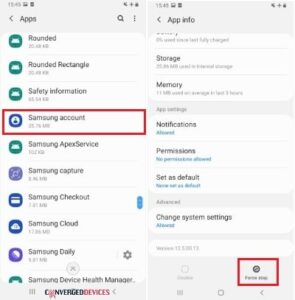What Is Com.osp.app.signin on Android and Is It Safe? A Thorough Look
In the vast universe of Android, many apps and services work tirelessly in the background. One such service is the oddly named com.osp.app.signin, a feature many Android users have stumbled upon, perhaps not really understanding its purpose. This particular feature tends to stay out of sight in the steady stream of app notifications and settings updates, but it plays an important role in the functionality of Samsung Android devices
So, what is this mysterious com.osp.app.signin? And more importantly, is this something users should be concerned about in terms of security and privacy? The purpose of our journey in this article is to demystify com.osp.app.signin, reveal its exact functionality, and examine its security credentials.
What is com.osp.app.signin?
As an Android user, you may have come across various features and icons while browsing your device’s internals. com.osp.app.signin is one such feature that seems quite flexible but is tightly woven into the fabric of many Android, especially Samsung, devices.
Understanding com.osp.app.signin
Contrary to some misconceptions, com.osp.app.signin is not an application you can launch or interact with directly. Rather, it is a part of the system designated as a package. This package comes pre-installed on many Samsung Android devices and plays an important role in ensuring the smooth operation of these devices.
The role of com.osp.app.signin on Android devices
The com.osp.app.signin package serves a specific role in Android—it controls user login status. In other words, it’s the main part of the system that handles user authentication—for example, logging into your Google and Samsung accounts on your device.
- Acts as a helper for applications such as “Samsung account” or “Samsung Cloud” that require user authentication.
- Helps to keep Samsung devices connected seamlessly.
com.osp.app.signin start
To fully appreciate com.osp.app.signin, it’s important to focus on its origins and synchronization with Samsung devices. Peeling back the layers, it becomes clear that this seemingly simple package is actually connected to the core functionality of many Samsung Android devices
If you contact Samsung com.osp.app.signin
com.osp.app.signin meshes into the technological life of Samsung devices by interacting with the Android ecosystem. Think of it as a bridge between the operating system and proprietary Samsung products—its existence depends on its entrenched relationship with Samsung brands.
Previously installed on Samsung Devices
Given its core functionality of maintaining the seamless user experience found on Samsung devices it is no surprise that these devices come with pre-installed packages As an important component of the Samsung Android infrastructure, com .osp.app.signin is quintessential for better communication by users to sign their devices It is emphasized.
Com.osp.app.signin’s Permissions and Access on Android
Just like many other pre-installed packages on your Android device, com.osp.app.signin also requests certain permissions. These permissions signify the extent of system resources and data it can access to fulfill its role. Let’s delve into the permissions it requests and the potential impacts on your data and privacy.
Permissions Requested by com.osp.app.signin
Various system packages or apps request different permissions based on the tasks they perform. As an essential package for user authentication, com.osp.app.signin demands several permissions. Here are some that it requests:
- Full network access: This permission is vital, as the package needs to communicate with remote servers for user authentication.
- View network connections: This enables the package to verify your device’s connectivity status before initiating any processes that require a network connection.
- Control vibration: This permission facilitates haptic feedback associated with sign-in notifications and status updates.
- Prevent device from sleeping: This prevents the device from going into sleep mode during crucial operations like sign-in or syncing data.
OSP App Sign In: Is It Safe?
Is com.osp.app.signin Safe?
Before delving into the details, let’s address the critical question: is com.osp.app.signin safe? In order to accurately answer this question, it is essential to analyze the application’s security features, encryption protocols, and privacy practices.
Security Features
A well-designed OSP app should implement strong security measures such as encryption, two-factor authentication (2FA), and regular software updates. The sign in process should be protected using SSL encryption, ensuring that user credentials are secure during transmission.
Encryption Protocols
Secure Sockets Layer (SSL) or Transport Layer Security (TLS) encryption protocols should be used to protect the information exchanged between the app and the server. These encryption protocols create a secure connection, preventing unauthorized access and safeguarding sensitive data.
Two-Factor Authentication (2FA)
In addition to strong encryption, a safe OSP app should provide the option to enable two-factor authentication. This adds an extra layer of security by requiring users to input a secondary authentication method, such as a unique one-time code sent via text message or third-party authentication apps like Google Authenticator.
Privacy Concerns
It is vital that the OSP app adheres to privacy policies and regulations such as the General Data Protection Regulation (GDPR) or the California Consumer Privacy Act (CCPA). The app should have a transparent and accessible privacy policy specifically addressing how user information is collected, stored, and utilized.
Can you remove com.osp.app.signin?
The decision to uninstall or disable certain system applications, including com.osp.app.signin, may bring some questions to mind. It’s clear: what are the possible consequences of doing this? So, in this article we will explore what can happen if you decide to remove com.osp.app.signin and provide some brief instructions on how to proceed.
The result of removing com.osp.app.signin
Possible negative consequences
com.osp.app.signin plays an important role in managing login sessions and user authentication for Samsung devices and connected applications. Removing it could mean several things:
- Login Issues: The primary function of com.osp.app.signin is to manage login settings. Once removed, you may experience difficulties when trying to access Samsung services or other related applications.
- System instability: Being a part of system apps, its removal can make the device function unstable or inconsistent.
- Loss of Performance: Some product functions that rely on com.osp.app.signin for authentication may stop working properly or completely.
The potential for positive outcomes
On the flip side, if you encounter issues specific to com.osp.app.signin, disabling or removing it can fix such issues. however, such cases are rare and should be considered with caution.
How to Keep Your Android Device Safe and Secure
To maintain the security of your Android device, it is important to adopt certain practices and stay vigilant in the digital environment. Here are the best practices to ensure your Android device remains secure:
Best Security Practices
- Keep your device updated: Regularly check for and install updates for your operating system and apps. These often include security patches.
- Use secure lock screens: Protect your device with a PIN, password, pattern lock, or biometric authentication such as fingerprint or facial recognition.
- Download apps from trusted sources: Prefer the Google Play Store over third-party app stores to avoid the risk of unintentionally downloading malicious apps.
Vetting Apps and Permissions
- Check app permissions: Before installing an app, read the permissions it requests. Only download apps that ask for permissions relevant to their function.
- Read reviews and research apps: Look for reviews from other users and information from reputable websites to assess the legitimacy of an app.
- Use Google Play Protect: Enable this feature on your device; it helps detect and remove harmful apps.
- Regularly audit your installed apps: Periodically review the apps you have installed and the permissions you’ve granted, revoking any that seem unnecessary or intrusive.
conclusion
In this article, we focused on the critical issue of securing connected system applications such as osp app sign in on Android devices. Remembering these points can have a lasting impact on your device’s security:
- Update your software.
- Lock your device in safe ways.
- Be careful where you get your apps and what you install.
- Routinely monitor application access and assess the security of system applications.
The com.osp.app.signin function typically has a purpose in the Samsung device ecosystem, as it manages authentication processes. While the idea is to help ensure device security, monitoring your device regularly for security by understanding what pre-installed apps do reinforces control over your own data
Managing the security of an Android device is an ongoing process. This includes not only paying attention to the apps we download, such as com.osp.app.signin, but also how we manage device settings and our own behavior. Knowledgeable users are the first line of defense against security threats, making education on these issues important for everyone.



